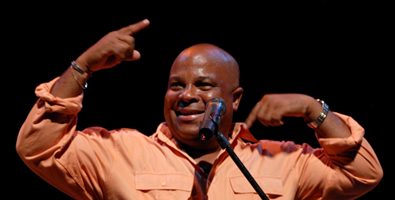12.19.18 Waldo Mendoza

Waldo Mendoza, a prominent Cuban singer, developed an interest in music from a very early age and took his first steps through a movement of amateur artists, thanks to which he participated in many grassroots festivals at the provincial and national levels.
A passionate admirer of the music of Silvio Rodríguez and Pablo Milanés, he began his university studies at the Guantánamo Higher Pedagogical Institute, where he began composing his first songs. During this time, he joined his first group, which included students from various majors and was appropriately named “Solidarity.”
Around that time, Waldo Mendoza wrote the song “Vivirás feliz,” a hit that earned him five special awards at the FEU National Festival, held in the province of Matanzas in 1985. This same song, sung by Angolan singer Euclides Lomba, became the most popular song on South African radio stations.
Some time later, the talented young man decided to change careers and pursue a Bachelor’s degree in Music Education at the Enrique José Varona Higher Pedagogical Institute. There, he joined “Son Imagen,” a group with which he had the privilege of being invited to the FEU International Festival held in Moscow, as a result of their national success at the festival, where the group won the Grand Prize.
Upon completing her university studies, without ever having taken a single singing lesson, she founded the group “La Idea” in the province of Santiago de Cuba and toured internationally, including countries such as Spain, Germany, and Czechoslovakia. Upon her return, she began performing at La Maisson in Santiago de Cuba, and later took her music to the Caribbean, performing in the Bahamas and Jamaica in 1995.
Waldo Mendoza later joined the “Salsa Caracol” orchestra, the “Cuarteto Patria”, “Alianza” and in 1997 founded the group “Tumbao Habana” with its director Pascual Cabreras, incorporating several of his own songs into the orchestra’s repertoire.
Over the years, he has become a popular artist in Cuba for the unique tone of his voice in romantic songs. Since going solo, he has been receiving nonstop hits.
Since leaving Tumbao Habana, Waldo Mendoza has had a space in his club at the Café Cantante of the National Theater (Paseo and 39th Street, Vedado, Plaza de la Revolución, Havana) every Saturday, where he has had the opportunity to share with artists such as Omara Portuondo, Jenny, Vania, Pablo Milanés, Kola Loka, Ricardo Leyva and many others.
Her debut solo album, titled “Bendito Tiempo,” was released in 2005 under the EGREM label. This album features songs such as “Que lindo es,” “Mala Hembra,” “Pasa un tiempo,” and other hits.
Five years later, Waldo Mendoza released his second CD, also released by EGREM and titled “Hojas del Alma.” Guitarist and composer Amed Medina was in charge of the musical production. The album was recorded in Havana, while the production, guitars, keyboards, and other elements were done in Mexico City. The photography was done by the immensely talented Ángel Alderete, and the graphic design was conceived by Moltó. The album features standout tracks such as “Cuéntale,” “Vivir sin Ti,” “Chiquitica,” and “Abre Caminos.” The CD was a huge success and earned a nomination for the 2010 Cubadisco Awards in the Songwriting category.
She is currently working on her third album, still unreleased, from which comes the hit single “De la Habana a Madrid.” On this album, she shares each track with Cuban popular music singers such as Mayito Rivera, Jenny Valdés, Robertón, Haila, Vania, Tania Pantoja, Ricardo Amaray, Juan Kemell, and David Álvarez.
It’s a different album because it’s more about popular dance music and at the same time features these singers performing ballads. Almost all of the songs are his own, while the arrangements were done by Eddy Cardoza, Osmani Collado, and Manolito Simonet, who also produced the album.
During 2011, Waldo Mendoza undertook a national tour throughout the country, beginning on July 14 and concluding in Matanzas on August 7.








